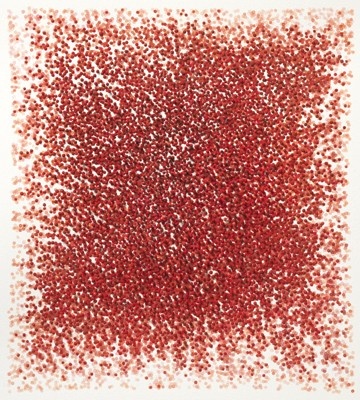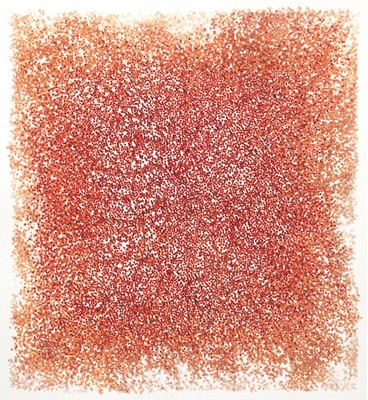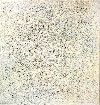New Paintings by Masako Kamiya at Boston's Gallery Naga
Minimal Austerity Hides Raw Passion
By: Shawn Hill - Sep 28, 2007
Masako Kamiya: New Paintings
Gallery NAGA
Newbury St, Boston
http://www.gallerynaga.com
thru October 6, 2007
Masako Kamiya's intensely focused project, at Boston's Gallery Naga. with additional works included in a show of Mass Council finalists at MCLA's Gallery 51 in North Adams, is awash in contradictions. The relative calm one sees at first is deceptive. Initially appearing minimal and austere, her paintings are actually full of hundreds of tiny marks, adding up to an evident frenzy of activity. From a distance they read as environmental fields, washed backdrops and silky veils, a bit like Monet's late, large misty water lily fantasies.
Only Kamiya's gouache paintings on panels aren't large at all, and they're seldom misty. Rather they are as solid and sure as sculpture, solid pieces of geometry covered in ridges and valleys of meticulously adhered painted dots. From the side view, up close, they're recall animal hide, some sort of skin that has reacted to the temperature or some threat, every "hair" standing on end.
Gouache tends to pastel shades, an opaque chalkiness. There are ways to combat that effect, and past shows of Kamiya's found her building in layers and ripples of energy in a multitude of colors, letting literal shadows do what the colors could not. Her energized surfaces seemed to seethe and melt from liquid to solid as you watched. In this show, the colors are very close, and the lines of force are quite minimal and homogenous. What forms can be found are like mirages in the air, impossible to focus on, ephemera leaving only an indistinct resonance in the corner of the eye.
The titles too are timeless, referencing vague and general moments rather than specific events or places. "Departure" has an all-over greenish hue, like a minty snowstorm, but, if so, it's a whiteout blizzard. "Emergence" shimmers through subtle circular patterns in Necco wafer shades: pink, mint, baby blue, ivory. You can make them out if you get close. From a distance, everything almost disappears into simple creamy white.
Kamiya has a secret weapon in her arsenal, however, and it's powerful: red. This ruddy, cadmium shade seeps into a few works, and its spreading presence indicates more dramatic events to come. Can we hope for a Pompeiian volcanic outburst someday? In "Transience" the red is lowest level of paint, drowning the colors around it from below, seeping out from the very center of the square. The color looks like rivulets of blood soaking a wound, or maybe exposed bone marrow.
Kamiya's works on paper often provide greater windows into her process than do the hermetically sealed paintings. On paper the painted areas have visible borders; the marks become clear participants in trapezoidal arenas defined by Kamiya. The paper buckles and swells from the liquid that has dried on it, and there's a feeling of playful experimentation and trial and error. Two gloriously red drawings engender rich and diverse associations.
"Momentum," the smaller one, is fractured and wild, intensely Titian tendrils invaded by pockets of white empty space (the paper left blank). Rather than a sense of congealing, spreading or engulfing, as in most of the paintings, the mood here is one of decomposition and destruction. The red tissue seems to be fraying and tearing around the edges, shredding before our eyes.
In "Remnant Sky," the texture recedes altogether at the edges, so we just see stained dots, in diverse shades of brown, orange and red. There's an autumnal mood, and again a sort of mesh is revealed in tatters and ruins. It's a bit scary, like being on the precipice of chaos, but also exciting.



